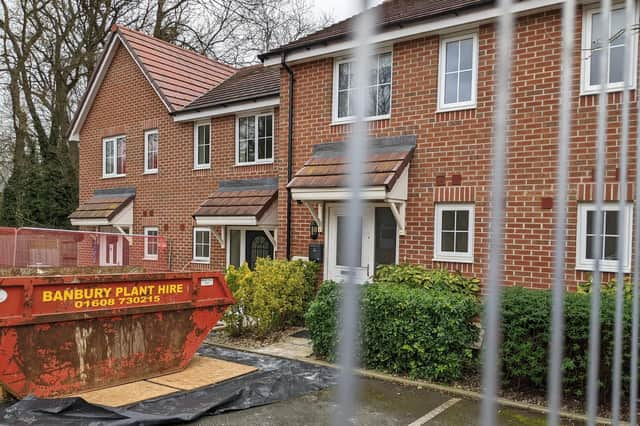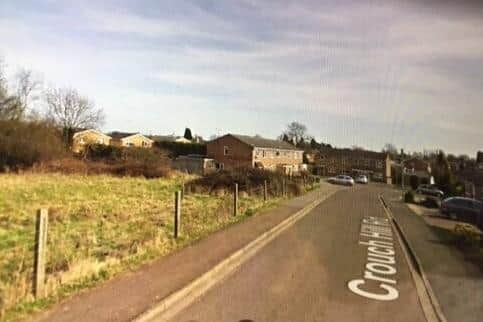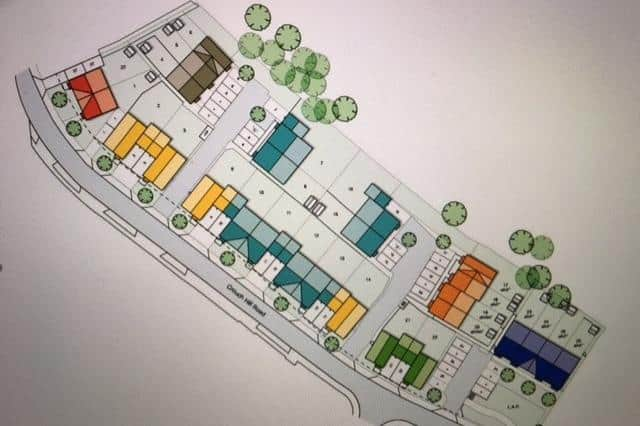'Tile cracked while kids were in the bath' says mum whose £300k new Banbury estate house began to move because of foundation fault


The mum of two said it took years of pressure before house builders Taylor Wimpey rehomed her in privately rented accommodation and agreed to rebuild her house and four others in the development in Crouch Hill Road, Banbury.
Meanwhile neighbours said claims that 'tree roots' had caused foundations to fail in six of the new homes were 'laughable'.
Advertisement
Hide AdAdvertisement
Hide AdThe mother, who does not want to be named, spoke to the Banbury Guardian after seeing the story about how house-builders Taylor Wimpey and the National House-Building Council (NHBC) were rebuilding the properties after the foundations failed and occupants suffered serious problems with their homes.


"Some occupants sold up and moved, and some of us were moved into temporary accommodation. I was living there as a single mother of two young children. About five years ago I noticed cracking in the wall and my front door was impossible to open at all sometimes because the frame has moved. There were lots of complaints and investigations," she said.
"At one point a tile in the bathroom cracked while my children were in the bath. This all progressed to four inch gaps in the walls with wind coming through, the boiler being condemned due to the movement so we had to live there for a winter with no central heating or hot water.
"It took years of pressure from me reporting not feeling safe in the house for anything to happen and was huge stress, especially when I was physically unable to lock my front door due to the movement shifting and changing the actual shape of the front door.
Advertisement
Hide AdAdvertisement
Hide Ad"I had to push and push to be moved into temporary accommodation which finally happened last March. No work started until late last month (January). The other four houses are housing association-owned.


"Surveyors who came regularly kept mentioning tree roots but some mentioned boggy grounds. They put in a temporary measure of a steel shoring prop in my living room (to keep the ceiling up) and that was there for two years before I was finally moved out."
The mum said her private rental accommodation is being paid for by the NHBC while work is carried out. She will not be able to move back in to the property until at least the end of August. She said two of the affected properties are privately owned and four are housing association homes.
The houses were built in 2014. The mum moved in during summer of 2017 and was rehoused in March 2021. She became aware of cracks within a few months of moving in.
Advertisement
Hide AdAdvertisement
Hide AdNeighbours and those who frequented the area long before houses were built have poured scorn on the claim that tree roots had caused the subsidence. On social media old Banburians said the area had been peppered with bogs, ponds and streams. One said he used to go newting around this area 50 yrs ago. He said there were two large ponds nearby.
One neighbour, living in the original 1930s houses on Crouch Hill Road said: "It makes me laugh that they are blaming existing tree roots. The trees are pre-existing and surely any builder worth his salt would have dug deeper foundations in the first place to compensate for the presence of trees, or be less greedy and not cram the cul-de-sac houses into the small gaps behind the houses on Crouch Hill Road itself.
"I don't know what building control was doing either - whoever signed off the too-shallow foundations should not have done so."
In a report this week (Monday) the Banbury Guardian was told by Taylor Wimpey: “We are sorry that a small number of properties in Crouch Hill have experienced problems with the foundations of their homes and sincerely apologise for any distress and disruption this has caused to residents. These problems relate to damage caused by existing tree roots.
Advertisement
Hide AdAdvertisement
Hide Ad“We have been working closely with the National Housebuilding-Council (NHBC), who are currently carrying out a programme of remedial work to the affected homes under their Buildmark warranty. We will continue to provide support where we can.”
The NHBC said: “We can confirm that we have been contacted by homeowners at the Crouch Hill Road development and are dealing with claims under the cover provided by their NHBC policy.”
"Housebuilding has to be inspected and signed off by building control officers are various stages of construction to ensure each element is sound before building continues. This can be done by the district council's building control team or it can be done privately, which happened in this case. The inspections were done and signed off by the NHBC. But they say the ultimate responsibility for quality control lies with the builder.
“As an Approved Inspector in England and Wales, NHBC Building Control Services Limited carries out plan assessments and periodic inspections at key stages of a development’s construction in order to assess, as far as is practicable, that homes conform to the Building Regulations in force at the time of construction.
Advertisement
Hide AdAdvertisement
Hide Ad"The building control function, whether it is provided by NHBC Building Control Services Limited, a Local Authority or another Approved Inspector, is not a replacement for the builder’s own quality control checks and obligations to build in accordance with Building Regulations. The primary responsibility for achieving compliance with the Building Regulations rests with the builder."
We have asked both organisations for a response to the most recent comments about the issue.